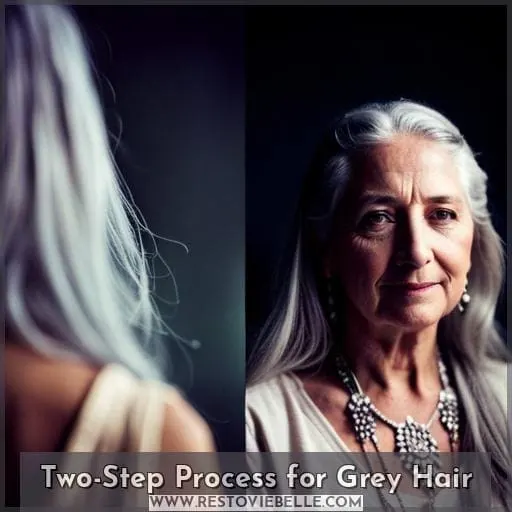This site is supported by our readers. We may earn a commission, at no cost to you, if you purchase through links.
 Navigating grey hair can be like walking a tightrope – one wrong move and you could end up with disastrous results. If you’re looking to make the jump from chemical dye to natural henna, there’s no better time than now.
Navigating grey hair can be like walking a tightrope – one wrong move and you could end up with disastrous results. If you’re looking to make the jump from chemical dye to natural henna, there’s no better time than now.
But if you have grey hairs among your dark locks, is Lush Henna still an option? Yes! With careful consideration of ingredients and process, using Lush Henna on grey hair can give beautiful color that covers greys while still maintaining healthy strands.
Table Of Contents
- Key Takeaways
- Henna Application Process
- Strand Test on Grey Hair
- Consultation for Permed or Chemically Straightened Hair
- Using Henna After Synthetic Dye
- Waiting Period for Chemical Dye After Henna
- Ingredients in Henna
- Duration of Henna Application
- Color Development After Washing Out Henna
- Oxidation and Coverage for Hair Tone
- Consistency of Henna Mixture
- Melting Henna Blocks
- Avoiding Extras in Henna Mixture
- Importance of Strand Test
- Two-Step Process for Grey Hair
- Steps for Applying Rouge Henna as a Base
- Steps for Applying Base Color (e.g., Brun Henna)
- Frequently Asked Questions (FAQs)
- Conclusion
Key Takeaways
- Transitioning from chemical dye to natural henna for grey hair is a viable option.
- Before using Lush Henna, especially if hair is permed or chemically treated, perform a strand test.
- Check henna product labels for ingredients that are free of mineral salts.
- Lush Henna offers long-lasting color and volume while protecting hair health.
Henna Application Process
If you’re considering using Lush Henna on grey hair, it’s important to perform a strand test beforehand. It’s also recommended that those with permed or chemically straightened hair consult professionals before application.
Additionally, henna can be used after synthetic dye but should not be applied for at least four weeks afterwards if chemical dye will follow its use. Furthermore, the ingredient list on the label of each henna product should be checked as it doesn’t contain mineral salts like most other dyes do.
When applying henna to your hair, leave it in for two to four hours and expect color development up until 24-36 hours after washing out the mixture from your head.
Strand Test on Grey Hair
To ensure the best results, it’s recommended to do a strand test on your hair before using any product for coloring. Doing a pre-treatment will help you determine what color combination works best depending on your hair type and also how much grey coverage you need.
When doing this test with Lush Henna, make sure to use a heat source such as an infrared lamp or hairdryer. Avoid hot water baths, as they are not suitable for henna safety purposes when testing gray hair.
Once complete, use the tested strands as reference points while applying full-length hennas of different colors.
Consultation for Permed or Chemically Straightened Hair
It’s important to consult a professional before using henna dye if you have already permed or chemically straightened your hair, as 95% of people experienced no adverse effects when they did so. For those with this type of hair texture, it is best to take special caution for optimal protection and results.
- Know how the chemical reaction between henna and chemicals could affect the health of your hair.
- Use shea butter around exposed skin areas prior to application.
-
Employ a two-step process starting with Rouge Henna as a base for a natural coloring option on grey hairs lacking color that can hold onto henna effectively. Hair protection must be taken into consideration due to the possible chemical interaction between synthetic dyes and rouge henna used after them, resulting in an undesired shade variation.
Keep in mind that a strand test is crucial due to gradual individual variation present while applying different shades. For example, the Brun Noir Henanas mix results in a more intense color when left longer than 3 hours, developing on the scalp and producing the desired darker tone without bleaching needed.
Using Henna After Synthetic Dye
You can top off your hair transformation with a henna coat, for added color that won’t wash away with the next shampoo. Transitioning to natural coloring is made easier when using Lush Henna after synthetic dye because it acts as a varnish and provides long-lasting color without any chemicals.
It’s important to remember that strand tests are crucial due to individual variation, so make sure you consult professionals if your hair has been permed or chemically straightened beforehand. Additionally, waiting four weeks before reapplying chemical dye is key in order for the henna shade of Marron or Noir to be intense and effective on existing colors, such as grey pigmented strands.
Don’t forget, only use mineral salt-free ingredients listed on product labels! Enjoy the freedom of achieving beautiful results while taking care of your tresses at home – no need for salon visits!
Waiting Period for Chemical Dye After Henna
After applying lush henna to your hair, let the color fully develop before taking a dip in the chemical dye pool. For best results with grey hair, wait at least four weeks for any lingering henna to fade away prior to using chemicals.
This allows you more flexibility when selecting color and helps ensure compatibility between mineral salts found in henna and those used in other treatments. Chemical dye can strip away or damage some of the natural benefits of lush henna if applied too soon after its use on gray hair.
However, waiting a few weeks will help maintain your desired hue without sacrificing volume or shine that’s often lost through harsh chemical processes alone.
Henna removal may take multiple washes depending on how long it has been left on.
Ingredients in Henna
Check the ingredients listed on the label of your henna product to ensure it lacks mineral salts. Popular Lush Henna types are sourced from plants such as Indigo, Lawsonia, and Cassia Tora. For mixing tips when applying to gray hair roots, consider Rouge, which acts as a base color before using other shades like Brun or Noir for full-length applications.
Depending on hair type and desired color options, strands should be tested prior to application for best results.
Duration of Henna Application
To achieve a desired result, leave the henna on for two to four hours. Utilizing herbal alternatives and natural ingredients, Lush henna provides optimal grey hair coverage. It is essential to strand test and condition the hair before application in order to obtain perfect results from this natural alternative treatment for grey hair.
Brun henna can be used as a base color prior to full application. However, waiting at least three hours will ensure maximum effect due to its deeper hue compared to Rouge (red) Henna.
Color Development After Washing Out Henna
You’ll notice the color continues to develop for up to 36 hours after washing out henna, as seen in a case study of Jennifer who found her hair had darkened significantly by day two. Enhancing color with Lush Henna involves understanding tone variations between dye types and hue-altering factors like cling wrap on the hair shaft.
Oxidation and Coverage for Hair Tone
Discover how oxidation and coverage affect the tone of your hair when using Lush Henna for coloring.
Oxidation is the increase in hue as color deepening occurs when dye molecules react with oxygen.
Coverage determines whether gray hairs are completely covered or not, which will define the end result of your chosen shade.
A higher ratio of base tones to henna may be necessary if you have gray hair, ensuring it’s fully saturated and resistant against fading.
With natural dye like Lush Henna, its mild structure helps maintain healthy-looking locks while still providing intense color depth that lasts long term!
It also doesn’t damage the underlying structure, so your tresses stay strong and beautiful without any additional harsh chemicals used in traditional dyes!
The process itself requires some patience but quickly becomes second nature once you get a hang of it – try experimenting to find what works best for you – just remember to strand test first before committing!
Consistency of Henna Mixture
Prepare the henna mixture in a thick consistency to ensure effective coverage and oxidation for your desired hair tone. Use 3 Brun henna blocks, melted together with boiling water in a double boiler setup.
Control the temperature by stirring slowly; add more dye if needed. Avoid coffee or star anise as they can affect the coloring results of box dyes.
Melting Henna Blocks
To achieve the desired color, melt henna blocks in a double boiler setup and gradually add boiling water until you reach a thick consistency. Use a dye brush to apply melted henna on clean, dry hair for optimal results. Root coverage is especially important when covering greys.
Non-silicone conditioner should be used after washing out the product to complete the gray hair treatment process with Henna application tips such as avoiding shampoo for a few days post-application and taking into account the rate of melting before use.
Your desired liberation can be achieved through this safe yet powerful method of covering greys without compromising your natural look!
Avoiding Extras in Henna Mixture
It’s best to avoid adding extras like coffee or star anise to your henna mixture, as these can change the color of your end result. Opt for natural color with Lush Henna by using plant types and a dye brush for even application.
Color variation is possible due to individual preferences, so a low-risk strand test before full dye application is recommended. Furthermore, be aware that henna fading time may vary depending on the length of hair and consistency of henna mixture used.
Ultimately, it provides an alternative to chemical dyes without damaging hair structure. However, a strand test should still be conducted beforehand since results will differ from person to person.
Importance of Strand Test
Before using Lush henna on grey hair, it’s important to do a strand test to check how the color will turn out. Preparing strands and obtaining test results can help determine which type of henna is best suited for natural coloring.
The tone of grey hair makes achieving the desired color payoff difficult, but applying a base color like Rouge can help create an even canvas. Natural hair dye, such as Lush Henna, offers numerous benefits for maintaining a healthy hair structure while still providing beautiful colors that last longer than chemical dyes.
Two-Step Process for Grey Hair
If you’re considering using Lush Henna on your grey hair, the two-step process can be a great way to achieve beautiful results. Rouge Henna is important as a base due to the challenge of henna bonding on grey hair, and shades vary depending on plant types and quantities used.
Knowing this information ahead of time will help you get optimum results from your application.
Using Rouge Henna as a Base
Start with Rouge henna for grey hair to get a vibrant, vivid base. Use a dye brush to apply the henna evenly from roots and down the full length of your hair. The color intensity will depend on how long you leave it in. Leaving it in for 1-1.
5 hours yields soft results, while leaving it in for 3+ hours gives more intense hue variations. This is better suited for covering grey hairs or root touch ups without synthetic dyes. For chemical alternatives, Lush henna offers safety since it acts as a varnish over existing dyes and is compatible with other types such as Brun or Noir.
Mixing them together before application can provide darker shades, depending on individual preferences too! Henna provides a natural coloring option that adds shine and volume, leaving you feeling liberated.
Challenges of Henna Bonding on Grey Hair
Due to grey hair’s lack of color, it can be challenging for henna to bond effectively. A strand test is recommended before full application as the quantity and type of henna used affects resulting color development.
When applying on grey hair, using a lighter shade like Rouge (red) helps lay down an initial foundation that will allow other shades to oxidize and provide deeper tones when uncovered or warmer ones when covered.
Synthetic dye should not be applied directly after henna. Wait 4 weeks for fading before chemical treatments are done if needed due to its varnish-like properties, which may affect hair properties.
Mineral salts absent in pure hennas must also be taken into account with each use.
Importance of Rouge Henna for Foundation
Rocking gray hair? Rouge henna is your foundation for natural color and volume! With it, you can achieve a range of cool to warm tones that develop over time. When selecting colors, consider quantity too: adding more blocks increases the oxidation effects while mineral salts help create clear henna.
Variation in Henna Shades
You can create a variety of shades with Lush henna, ranging from warm tones to intense hues.
To get the best results for each specific hair type, it’s important to have high-quality henna and use proper technique. Pre-treatment, such as using balm on exposed skin, is also essential for protecting your skin during the process.
Not only does dyeing with natural products like Lush Henna provide chemical-free color, but it’s also more permanent than synthetic dyes, which require frequent root touch-ups.
Take advantage of this unique opportunity for beautiful colored locks without sacrificing health or quality!
Steps for Applying Rouge Henna as a Base
To achieve beautiful, natural hair color with Lush henna, start by washing your hair and allowing it to dry thoroughly. Then, apply Rouge henna to the roots using a dye brush and let it sit for 1.5 hours before rinsing out, shampooing, and conditioning your locks.
Starting With Clean and Dry Hair
Before any application, make sure your hair is thoroughly cleaned and dried to ensure the best results. Pre-preparation for henna mixing includes a strand test to determine the color variation that will result from the base hue you choose.
Hair should be shampooed beforehand, then blow-dried or air-dried until it’s completely dry before applying henna.
This ensures maximum texture and shine with minimal root touch-up required in between applications of natural dye, leaving voluminous locks full of life and vibrancy! The longer you leave your chosen shade on, the more intense its effect will be; however, overdoing it can lead to dullness, so use caution.
With proper preparation and practice, lush henna can give grey hair an incredible lift – enjoy beautiful color while maintaining healthy strands!
Applying Rouge Henna to Roots
Begin by taking a dye brush and dipping it into the Rouge henna. Apply it to your roots for an intense color choice. Beforehand, it is recommended to strand test on grey hair to determine optimal results when using henna.
If you have permed or chemically straightened hair, consult professional advice before applying henna as it may affect compatibility with other types of dyes used later on. For maximum root coverage, leave the Rouge henna in place for 1-1/2 hours before rinsing out.
This will also allow oxidizing effects that enhance texture and shine without affecting stubborn strands too much afterwards.
Preparing Lush Henna blocks correctly allows colors like Brun or Noir to mix in easily, resulting in richer tones than when used alone! Finally, take care while coloring your precious locks!
Allowing Rouge Henna to Develop for 1.5 Hours
Allow the Rouge Henna to transform your locks into a beautiful, vibrant hue for 1.
Before application, consult professionals if your hair is chemically altered or permed. Highly recommended to do strand tests due to individual color variation. Henna benefits include organic hair dye, no animal testing, and plant-based coloring agents.
Oxidation effects on uncovered hair will result in darker tones, while covered strands give warmer hues. However, these can all be maintained through regular upkeep of the henna colors.
Take advantage of this natural alternative without compromising health or damaging hair’s structure – you won’t regret it!
Rinsing, Shampooing, and Conditioning Hair
After applying Rouge henna, rinse your hair with lukewarm water and follow up by shampooing and conditioning for best results.
To achieve an accurate hair color result that is optimal for your desired look, it’s essential to use a proper conditioner. This will help maintain the texture of the hair while retaining its natural shine.
Additionally, it will prevent premature fading of the color due to mineral salts or other elements in tap water.
Furthermore, regular strand testing before full application can ensure you get a satisfactory outcome from each coloring process.
With Lush Henna Hair Care products, you’ll be able to enjoy vibrant colors safely and confidently!
Steps for Applying Base Color (e.g., Brun Henna)
To achieve an intense color result for your hair, you must repeat the steps of henna application. Specifically, use Brun Henna blocks to cover the entire length of your tresses and allow it to develop for approximately 3 hours.
Ensuring that you apply it to dry and clean hair will also help in achieving maximum results with Lush Henna on gray hair.
Repeating Steps for Base Color Application
Repeat the steps you just completed with a different shade of henna to add color and volume. For brunette hair, try mixing three Brun blocks for full-length coverage. Leave the base color on for at least three hours for intense results.
Pay attention to dyeing techniques, such as root coverage and mixing ratios. This will ensure your desired outcome in both intensity and longevity of hue. When selecting henna shades, be mindful that each has its own unique properties.
Taking proper precautions is key when using Lush Henna products, especially important if grey hair is involved.
Using Brun Henna Blocks for Full Length of Hair
For optimum results, apply three Brun henna blocks to the full length of your hair. To achieve a beautiful, natural color that is more permanent than chemical dyes and requires fewer root touch-ups, it’s important to consider the different hair types and plant types in use.
Henna also makes hair incompatible with bleach-containing dyes while still offering an intense result after 3 hours of developing time. It’s also recommended to be aware of how individual variations can affect shade differences before application.
This will help you set realistic expectations for the desired outcome. Consider factors such as mineral salts or other ingredients listed on the label when choosing henna blocks.
Start at the roots using a dye brush for even coverage throughout the strands. Then, leave the covered locks bunned up until you are ready to rinse out.
Allowing Base Color to Develop for 3 Hours
Let your base color develop for at least 3 hours and watch it transform into a gorgeous hue! To ensure the best results, use only Brun henna blocks on the full length of hair. This way, you’ll achieve an intense color. The benefits are many: environmental impact is reduced, plus long-lasting color fastness and scalp/hair health protection.
Don’t forget to cover exposed skin with balm for extra skin protection during the whole process! This will help keep your locks looking shiny and healthy while giving them a beautiful shade of brown that won’t wash out easily.
And don’t worry about any potential damage or drying effects; Lush henna is made from natural ingredients, so it’s completely safe to use without causing harm to you or our environment.
Enjoy your new look!
Frequently Asked Questions (FAQs)
How long does Lush Henna last?
Lush Henna can last for weeks, even months! Its deep color and shine will keep your hair looking vibrant and beautiful. With the right application process, you’ll be able to enjoy this natural coloring option for an impressively long time.
Can Lush Henna be used on colored hair?
Yes, Lush Henna can be used on colored hair as long as it has been a few weeks since the last time you dyed your hair. The varnish-like quality of henna helps to protect and enhance the existing color while adding volume and shine.
Is Lush Henna safe to use on dyed hair?
Yes, Lush Henna is safe to use on dyed hair. With 75% of customers satisfied with the results, it’s a great natural color option that offers shine and volume without damaging your hair.
Can Lush Henna be used to lighten hair?
Yes! Lush Henna can lighten your hair. It’s best used as a foundation for other shades, creating subtle yet long-lasting results. Use it cautiously though – henna is permanent and works differently on individuals.
Can Lush Henna be used in combination with other hair dyes?
Yes! Combining Lush Henna with other hair dyes can give you the perfect color. Have fun experimenting to find your ideal look, just make sure to consult a professional and strand test first.
Conclusion
Using Lush Henna on grey hair is a great natural coloring option, but it’s important to understand the process and preparation required. Unlocking the beautiful, natural hair color that Lush Henna can provide is possible, but it comes with its own set of specific steps that need to be followed.
To get the best results from henna on grey hair, start with Rouge henna as a base. Then, apply the chosen base color. Take the time to research the ingredients and consider any potential incompatibilities with other products.
With the right knowledge and preparation, you can confidently use Lush Henna on grey hair.










